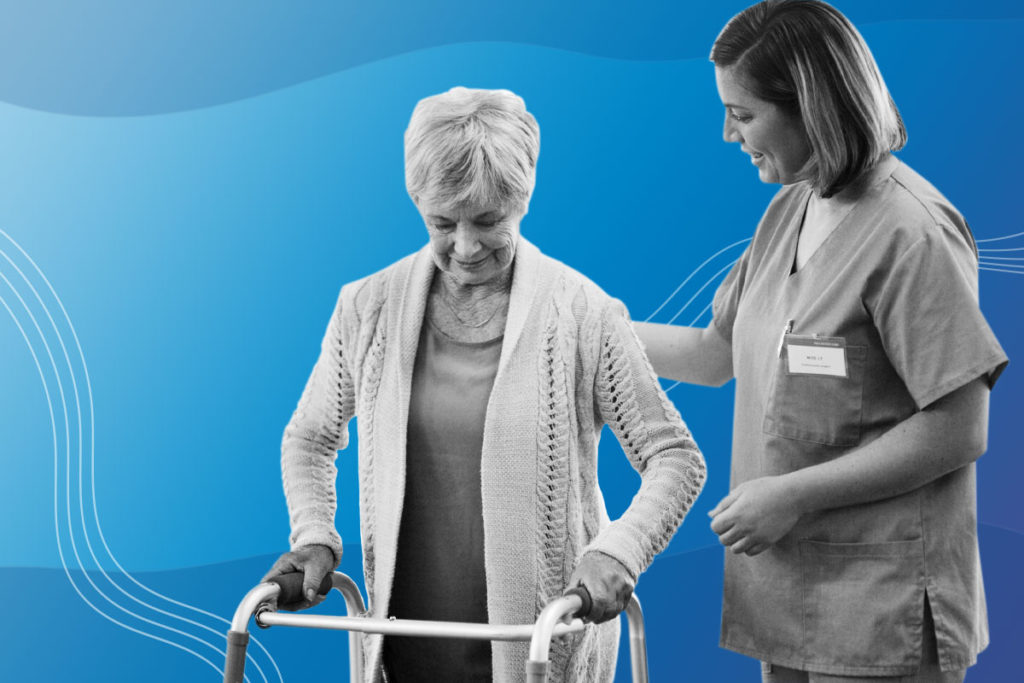
Some of the links on this page may link to our affiliates. Learn more about our ad policies.
Knowing When It May Be Time For Assisted Living
Updated on: June 2023

One of the most difficult tasks we face as humans living in a society is how we take care of our beloved elders. There may come a point in time when a senior can no longer live on their own, though, so as members of their families, we must make difficult decisions regarding how we handle this situation.
On one hand, it’s emotionally taxing to see someone you love not be able to take care of themselves when they used to be the one taking care of you. But on the other hand, there’s only so much you can do to take care of a senior in your family until it becomes overbearing and inhibits your ability to live a normal life. There’s a middle ground that can often be found when it’s necessary. That’s particularly true at a certain point where it makes sense for both the senior and the caregiver to develop a plan for senior care. But this is an expansive industry, so it’s important to determine which type of care you or a loved one may need. Our article about the future of senior care can also help you plan for new types of care that may be better suitable for you or a loved one.
Find What You Need
How Do I Know What Type of Care I Need?
One way to measure the level of care a senior needs is through charting ADLs, which are activities of daily living. This concept was developed by a doctor named Sidney Katz back in the 1960s, and it helps professionals understand how well a senior can complete routines and basic activities that contribute to daily life. Katz broke these routines down into six main categories:
- Bathing
- Dressing
- Toileting (going to the bathroom)
- Transferring (the ability to get in and out of bed)
- Continence (being to control your bowels)
- Feeding
Each category has equal value of importance in Katz’s chart. A number—1 if you can complete the task, or 0 if you can’t—is assigned to each category. Once that is done, you add up the numbers. The higher the score, the more independent a patient is able to live. For example, if a senior scored a five out of six on the model, he or she has a relatively easy time completing basic functions of life. But if a senior scores a one or two out of six, it’s clear that he or she needs a lot of care and attentiveness, and thus will need a type of senior care that is more hands-on. Once professionals measure ADLs, there are other types of more broad activities they gauge to get a deeper understanding of the type of care a senior needs. These activities are called IADLs, or instrumental activities of daily living. These include activities like:
- Paying the bills
- Cleaning the house
- Cooking food for yourself
- Being able to transport yourself outside of the house
- Socializing
These activities are measured in a similar fashion as ADLs, with numbers being assigned to specific activities. But because IADLs are far more expansive than ADLs, the number ranges are different. The ranges are different for men and women, too, in order to avoid any potential gender bias. For men, the scores range from zero to eight, and for women, the highest number is lowered to five. They’re similar to ADLs in how they’re measured, though, because the higher the score, the more likely that someone can live more independently (and vice versa).
Signs it May be Time for Assisted Living
Outside of understanding exactly what ADLs and IADLs are and how important they are to senior care, there are general warning signs and hints that it may be time for assisted living. Many of these signs are directly related to the activities of daily living discussed before and can be explained medically. That could be because the senior in question is depressed or they have something more severe like dementia or cancer. For example, a bad odor can mean they don’t know how to or simply don’t have the physical strength to bathe anymore. Unpaid bills may mean they don’t have the cognitive ability to understand numbers like they once could. Now without filling out an ADL chart, what are some signs that may indicate it’s time to seek professional help regarding your loved one’s living situation?
Worsening Medical Conditions
As seniors age, the likelihood they develop a chronic medical condition skyrockets. The AARP reported that more than 70 million people (aged 50 and older) have at least one chronic medical condition, and these can be debilitating issues like Alzheimer’s disease or heart disease. When seniors with conditions like this get older, they need more and more medical attention and are less capable of taking care of themselves. Outside of chronic conditions, the potential for medical emergencies increases with age. If your loved one indicates that he or she has fallen and struggled to get up on more than one occasion, it’s not safe for them to be living on their own. Nearly one third of seniors fall at least once every year, and the death rate for falls has climbed steadily in the past decade.
Monetary Issues
Many aging seniors have less of an ability to keep up with all their financial responsibilities. Bills from banks and insurance can pile up because seniors either don’t have the motivation to pay them or they simply can’t. Diseases like dementia also affect seniors’ ability to think abstractly and handle numbers on a complex level. This can lead to difficulties when doing taxes or taking care of multiple bills at one time. Seniors can also often be susceptible to financial scams, whether it be from telemarketers or their own family members. These scams can put seniors in debilitating financial spaces, which can prevent them from taking care of themselves—if they live in their own home or not. Many aging seniors have less of an ability to keep up with all their financial responsibilities. Bills from banks and insurance can pile up because seniors either don’t have the motivation to pay them or they simply can’t. Diseases like dementia also affect seniors’ ability to think abstractly and handle numbers on a complex level. This can lead to difficulties when doing taxes or taking care of multiple bills at one time. Seniors can also often be susceptible to financial scams, whether it be from telemarketers or their own family members. These scams can put seniors in debilitating financial spaces, which can prevent them from taking care of themselves—if they live in their own home or not.
Isolation
Senior isolation is a serious problem. More than 11 million seniors live alone, according to the U.S. Census, and isolation can affect seniors’ overall health. When seniors isolate themselves, that means they decrease how often they participate in things their hobbies, social interactions with family and friends, or just simply leaving the house at all. Some health issues associated with isolation include:
- Depression: The lack of community or sense of purpose can cause seniors to become depressed, which is an agent for disease like dementia and heart disease.
- Addiction : Seniors who are isolated often develop bad health habits like drinking, smoking cigarettes, and prescription drug abuse.
- Mortality : Simply put, isolation is directly related to seniors’ mortality rate, according to one study.
Messy Living Space
An untidy and odorous living space can indicate a senior may not be able to live on his or her own anymore. These can often be explained with a senior’s physical ability to clean up after themselves, because it can get to the point where they can’t vacuum the house or clean the dishes (or even get dishes into the dishwasher). It’s also important you look at the food your loved one is eating. Open up the fridge and look around. Is there spoiled food stacked on top of spoiled food? Are there a lot of foods past their expiration date? Is there a lot of the same food, like leftovers of the same thing from the same restaurant? All these may be signs that your loved one 1) can’t cook for him or herself anymore and 2) aren’t eating healthy food or full meals, which causes a general unhealthiness. An untidy and odorous living space can indicate a senior may not be able to live on his or her own anymore. These can often be explained with a senior’s physical ability to clean up after themselves, because it can get to the point where they can’t vacuum the house or clean the dishes (or even get dishes into the dishwasher). It’s also important you look at the food your loved one is eating. Open up the fridge and look around. Is there spoiled food stacked on top of spoiled food? Are there a lot of foods past their expiration date? Is there a lot of the same food, like leftovers of the same thing from the same restaurant? All these may be signs that your loved one 1) can’t cook for him or herself anymore and 2) aren’t eating healthy food or full meals, which causes a general unhealthiness.
Poor Hygiene and Frailty
While a loved one may have some level of ability to take care of him or herself, a big sign it may be time for assisted living is the lack of motivation for doing so. Some signs of poor hygiene include messy grooming habits and a bad odor, which could indicate they aren’t bathing as often as they should or doing laundry. This can also mean they’re starting to lack the ability of taking care of themselves, too. Seniors can also start to become frail as they age, meaning they look skinnier or thinner than usual. This can be caused by a lack of eating, or something more serious like a medical problem that hasn’t been addressed yet.
What Kinds of Senior Care are There?
The senior population (adults 65 and older) is taking up a greater portion of the overall United States population every year thanks to the baby boomer generation (those born between 1946 and 1964). In 1985, seniors took up about 12 percent of the population. Current levels are at about 13 percent (more than 40 million people), and that number is expected to rise to up to 21 percent by 2050. That means there will be more than 80 million seniors living in the States at one time, which will require a great deal decision-making for a lot of families as to when and what type of care they should get for their loved ones once they can no longer live on their own. Luckily, though, senior care is a wide-ranging and highly inclusive industry. There are plenty of options to make sure your loved ones are in the best hands. The amount of inclusive senior care you or a loved one needs varies depending on the level of care that’s needed. Let’s look at the different types of care there are and what fits your situation best.
Nursing Homes
Nursing homes feature round-the-clock assistance for patients who need highly attentive, long-term care. The average patient who enters a nursing home is there for around two and a half years. Seniors who reside in a nursing home usually have lower ADL and IADL scores. According to a survey in 1999, more than 95 percent of nursing home residents needed help with bathing, and 88 percent of residents needed help with getting dressed. Nursing homes require that a registered nurse (RN) be present at all times when patients are being cared for, though nursing homes can have different levels of skilled nurses present. Because of the amount of assistance each patient needs, the plans for each patient vary and there usually isn’t one overarching plan to take care of all the patients in the home. Usually, nursing home care isn’t covered by Medicare. The official website states the reason is: “most nursing home care is custodial care, like help with bathing or dressing. Medicare doesn’t cover custodial care if that’s the only care you need.” As of 2012, one report revealed that the average yearly cost of nursing home care is about $90,000 for a private room, and about $80,000 for a “semi-private room.” These prices vary depending on what state you live in and sometimes even what part of a state you live in. Depending on your insurance, part of the cost can be covered.
Assisted Living Care
Assisted living facilities are similar to nursing homes in that there’s 24-hour care, but usually patients in assisted living don’t need as intrusive care as nursing home residents. Like nursing homes, patients in assisted living facilities are expected to be there for the long-term, with an average patient staying for around three years. About seven times more women live in nursing homes than men, but that’s often attributed to the fact women are expected to live longer than men. Those who enter assisted living facilities can often do many activities on their own, but not enough to where they can comfortably and safely live alone anymore. Residents usually have their own living space and are still allowed to socialize with other residents freely. Meals are provided to residents, but some facilities allow patients to cook for themselves (if they are able). Assisted living communities are often paid for out of pocket, and yearly averages range from $25,000 to $50,000, depending on where and which facilities you choose to enter.
Home Health Care
Home health care is the most popular form of senior care because it allows seniors to live in a place they’re comfortable with, and it allows family to come and visit freely without any restrictions or time-sensitive rules. Depending on the type of care needed, some patients can travel and leave the home. Patients who receive home health care have a wide range of care from once or twice a week, to 24 hours a day. Professionals who treat patients with home health care usually assist patients with activities like:
- Bathing
- Going to the store
- Preparing food
- Getting dressed
- Transportation to appointments
Because of the wide range of care, home health services are usually offered hourly and can be covered through Medicaid and Medicare.
Independent Living Communities
There are also known as retirement homes and villages. Usually residents of independent living communities score pretty high on ADL and IADL scores, meaning they don’t need too much medical help. However, there are usually medical facilities in these communities. Because of this, the lifestyle can be relatively similar (or even better) than before because of the amount of people similar in age and the overall sense of community. These communities are particularly advantageous to seniors who are isolated. Isolation can cause depression and affect your overall well-being and health, so the sense of community given in a retirement village can help combat that. Retirement homes sometimes have social and entertainment activities like golf, tennis, gyms, and performing arts centers to help keep seniors engaged. Independent living communities are often one of the cheaper senior care options around, too, because of the lessened need for round-the-clock care. Because of the opportunity for entertainment and advanced amenities, costs can range anywhere from $2,000 a month to up to $4,000 a month.
Hospice Care
One of the toughest decisions you can make is putting a loved one into hospice care, but it’s the best and most comforting choice in certain situations. Hospice care is described as “the model for quality, compassionate care for people facing a life-limiting illness or injury” by the National Hospice Organization. It focuses on making sure patients live their last days in the most comfortable and pain-free environment possible. Hospice care has some of the most expansive rules on the Medicare website as to what is and isn’t covered, but they largely revolve around if the care is focusing on treating and attempting to cure any sort of malady.
Alzheimer’s Care
This type of care is specifically made for people with Alzheimer’s disease. Though that sounds like a specific type of care, more than five million people every year are affected with the disease. Alzheimer’s disease is the most common form of dementia (memory loss), and, at its more advanced stages, can cause patients to become immobile. Alzheimer’s care is tailored specifically for the disease. For example, there is greater security because patients with Alzheimer’s are known to wander, and it’s important to make sure that patients can’t escape the area. There are many different forms of care, though, just as there are different types of senior care that vary based on the severity of the disease. Sometimes, Alzheimer’s care is incorporated to other types of senior care like nursing homes and assisted living facilities. It’s through understanding these different forms of senior care that you and your loved ones can feel more confident and comfortable with making such an important decision.

